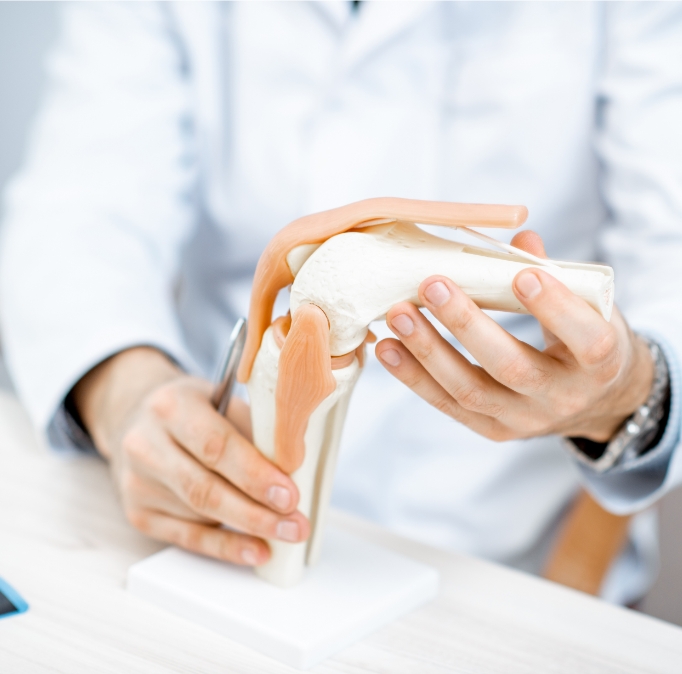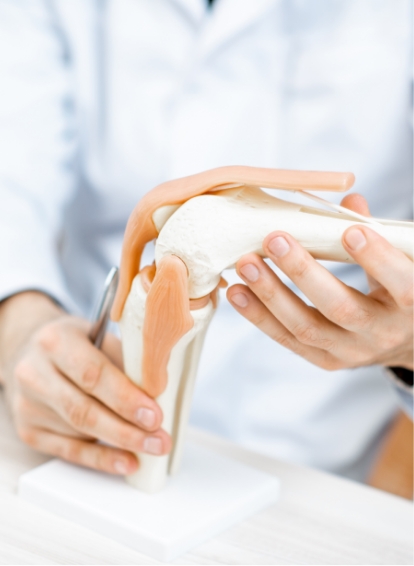Sports & Non-Surgical Orthopaedic Treatments
Persistent Joint Pain
Persistent joint pain is a chronic issue affecting many individuals and can impact one or multiple joints in the body, including knees, hips, shoulders, and hands. This pain, often accompanied by stiffness and swelling, can interfere with daily activities and reduce quality of life. Persistent joint pain may result from various causes, including injury, wear and tear, or chronic inflammatory conditions.
At The Clinica, our experienced team in Sports & Non-Surgical Orthopaedics offers effective, personalised treatments to alleviate persistent joint pain, helping you regain mobility, ease discomfort, and improve joint function.

What is it?
Persistent joint pain refers to ongoing or recurrent pain that affects the joints in the body, often lasting for weeks, months, or even years. This type of pain may be sharp or dull and is typically accompanied by symptoms such as stiffness, swelling, or reduced movement. Unlike acute pain, which signals a recent injury or trauma, persistent joint pain continues over time and may worsen with physical activity or as the day progresses.
The joints most commonly affected include the knees, hips, shoulders, and hands, though it can impact any joint. Individuals experiencing persistent joint pain may find everyday activities, such as walking, climbing stairs, or even writing, challenging. Over time, if left untreated, persistent joint pain can lead to joint deformity, weakness, and a significant reduction in mobility.
Persistent joint pain can arise from several causes, including degenerative conditions like osteoarthritis, inflammatory diseases such as rheumatoid arthritis, or previous injuries that did not fully heal. Treating this condition requires a tailored approach, targeting the underlying cause to provide effective, long-term relief and restore quality of life.
Book an appointment
Additional Information

Causes of the condition
The causes of persistent joint pain vary, with the most common being degenerative and inflammatory conditions. Osteoarthritis, a degenerative joint disease, is one of the leading causes, where the cartilage protecting the bones within the joint gradually wears down. This deterioration can lead to bone-on-bone friction, resulting in pain, inflammation, and joint stiffness. Rheumatoid arthritis, an autoimmune disease, causes chronic inflammation in the joints, which over time can damage the joint structures and cause ongoing pain.
Injuries that affect the joints, such as fractures, ligament sprains, or tendon injuries, can also lead to persistent joint pain if not properly rehabilitated. The healing process may leave scar tissue or muscle imbalances, both of which can alter joint mechanics and cause discomfort. Overuse injuries from repetitive activities, common among athletes and individuals in physically demanding jobs, also contribute to chronic joint pain.
Certain lifestyle factors, such as being overweight, a sedentary lifestyle, or poor posture, can place added stress on joints, exacerbating wear and tear over time. Additionally, age and genetic predisposition can play roles in joint deterioration, increasing the likelihood of developing conditions that lead to persistent joint pain.
Tests that can be done to confirm the condition
Diagnosing persistent joint pain typically starts with a physical examination and a detailed review of the patient’s medical history and symptoms. The clinician will assess joint movement, pain levels, and any visible signs of inflammation, such as swelling or redness. Specific tests may be conducted to evaluate the stability, strength, and range of motion in the affected joint, helping to identify potential sources of pain.
Imaging tests, such as X-rays, MRI, and ultrasound, are frequently used to confirm the diagnosis and assess the extent of joint damage. X-rays are useful for visualising bone structures and can reveal signs of arthritis, bone spurs, or joint space narrowing. MRI provides detailed imaging of soft tissues, including cartilage, tendons, and ligaments, making it valuable for detecting conditions like osteoarthritis or ligament injuries. Ultrasound can help detect inflammation in real-time and is particularly useful for evaluating fluid accumulation or synovial thickening within the joint.
Blood tests may also be conducted to rule out inflammatory or autoimmune conditions, such as rheumatoid arthritis or gout. These tests can help identify markers of inflammation or infection that may contribute to persistent joint pain.
Effective treatments
Treatment for persistent joint pain aims to relieve pain, reduce inflammation, and improve joint function. Initial treatment often involves conservative approaches, such as rest, ice application, and over-the-counter pain relievers to manage mild pain and inflammation. Modifying activities that aggravate the joint, along with lifestyle changes, such as weight management and low-impact exercises, are essential to relieve joint strain.
Physical therapy is a cornerstone of managing persistent joint pain, focusing on exercises that strengthen the surrounding muscles, improve flexibility, and support joint stability. Strengthening exercises provide better support for the joint, reducing stress on the affected area, while stretching routines help relieve stiffness and improve range of motion. For cases where posture or gait contributes to joint pain, ergonomic adjustments may be recommended.
For patients with chronic inflammation or advanced arthritis, non-surgical treatments, such as corticosteroid or hyaluronic acid injections, can provide temporary relief by reducing inflammation and lubricating the joint. Platelet-rich plasma (PRP) therapy is an emerging option that uses the body’s own platelets to promote tissue healing and reduce pain in damaged joints. In severe cases, surgery, such as joint replacement, may be necessary to restore function and relieve pain. Post-surgical rehabilitation is essential to ensure successful recovery and long-term joint health.
Book an appointment for an initial consultation
Booking an initial consultation at The Clinica is the first step towards effective management of persistent joint pain. During this session, our specialist will conduct a thorough assessment, discussing your symptoms, reviewing your medical history, and identifying any activities that may contribute to joint stress. A detailed physical examination of the affected joint will help determine the severity of the condition and guide the next steps.
If necessary, imaging tests and blood work will be arranged to confirm the diagnosis and evaluate the extent of joint damage. Based on the findings, a personalised treatment plan will be developed, focusing on pain relief, rehabilitation, and strategies to improve joint health and prevent recurrence, ensuring a structured approach to recovery and long-term well-being.
Frequently Asked questions
Recovery time depends on the underlying cause and severity of the pain. Some cases may improve within weeks with conservative treatment, while others may require ongoing management for long-term relief.
Yes, many cases of persistent joint pain can be effectively managed with non-surgical treatments, including physical therapy, medications, and lifestyle adjustments. Surgery is generally reserved for severe or unresponsive cases.
Corticosteroid and hyaluronic acid injections are generally safe and can provide temporary relief from pain and inflammation. They should be used under medical guidance as part of a comprehensive treatment plan.
Low-impact exercises, such as swimming, cycling, and stretching, help relieve joint pain and improve flexibility without putting excessive strain on the joint. Strengthening exercises also support the joint structure.
Maintaining a healthy weight, engaging in regular low-impact exercise, and making ergonomic adjustments to reduce joint strain can help prevent the recurrence of persistent joint pain.
Specialised Clinics
General Enquiries
Please send your enquiry to us and our Practice Manager will be in touch shortly. Alternatively, if you would rather speak to us or your enquiry requires our urgent attention, please call us on 01344 946363.








